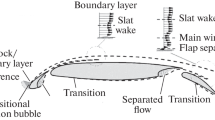Abstract
An immersed boundary method on unstructured meshes is used in serial eddy-resolving simulations of turbulent flows over individual bodies with a changeable configuration and position. The corresponding numerical technique is based on mesh deformation and dynamic adaptation of a moving mesh without changing its topology. The described approach makes it possible to substantially reduce the computational costs of serial computations with variations in geometric parameters aimed at optimizing the shapes of airfoil elements. The performance of the technique is demonstrated by simulating the aeroacoustic properties of a two-element airfoil segment involving a leading-edge slat with changeable geometry.












Similar content being viewed by others
REFERENCES
Ph. Angot, C.-H. Bruneau, and P. Fabrie, “A penalization method to take into account obstacles in incompressible viscous flows,” Numer. Math. 81, 497–520 (1999).
G. Iaccarino and R. Verzicco, “Immersed boundary technique for turbulent flow simulation,” Appl. Mech. Rev. 56, 331–347 (2003).
L. Mochel, P.-E. Weiss, and S. Deck, “Zonal immersed boundary conditions: application to a high-Reynolds-number afterbody flow,” AIAA J. 52 (12), 2782–2794 (2014).
I. V. Abalakin, A. P. Duben, N. S. Zhdanova, and T. K. Kozubskaya, “Simulating an unsteady turbulent flow around a cylinder by the immersed boundary method,” Math. Models Comput. Simul. 11 (1), 74–85 (2019).
N. S. Zhdanova, A. V. Gorobets, and I. V. Abalakin, “Supercomputer simulations of fluid-structure interaction problems using an immersed boundary method,” Supercomput. Front. Innovations 5 (4), 78–82 (2018). https://doi.org/10.14529/jsfi1804
A. P. Duben’, N. S. Zhdanova, and T. K. Kozubskaya, “Numerical investigation of the deflector effect on the aerodynamic and acoustic characteristics of turbulent cavity flow,” Fluid Dyn. 52 (4), 561–571 (2017).
V. A. Garanzha, L. N. Kudryavtseva, and S. V. Utyuzhnikov, “Variational method for untangling and optimization of spatial meshes,” J. Comput. Appl. Math. 269, 24–41 (2014). https://doi.org/10.1016/j.cam.2014.03.006
V. A. Garanzha and L. N. Kudryavtseva, “Hypoelastic stabilization of variational algorithm for construction of moving deforming meshes,” in Optimization and Applications OPTIMA 2018, Ed. by Evtushenko Y., et al., Communications in Computer and Information Science (Springer, 2018), Vol. 974, pp. 497–511. https://doi.org/10.1007/978-3-030-10934-9_35
C. Mockett, M. Fuchs, A. Garbaruk, F. Thiele, M. Shur, M. Strelets, A. Travin, and P. Spalart, “Two non-zonal approaches to accelerate RANS to LES transition of free shear layers in DES,” Notes Numer. Fluid Mech. 130, 187–201 (2015).
M. L. Shur, P. R. Spalart, M. Kh. Strelets, and A. K. Travin, “An enhanced version of DES with rapid transition from RANS to LES in separated flows,” Flow Turbul. Combust. 95 (4), 709–737 (2015). https://doi.org/10.1007/s10494-015-9618-0
P. R. Spalart and S. R. Allmaras, “A one-equation turbulence model for aerodynamic flows,” AIAA Paper 92-0439 (1992). https://doi.org/10.2514/6.1992-439
A. P. Duben, “Computational technologies for simulation of complex near-wall turbulent flows using unstructured meshes,” Math. Models Comput. Simul. 6 (2), 162–171 (2014).
V. A. Garanzha and L. N. Kudryavtseva, “Hypoelastic stabilization of variational algorithm for construction of moving deforming meshes” (Springer Nature Switzerland AG, 2019). https://doi.org/10.1007/978-3-030-10934-9_35
I. V. Abalakin, T. K. Kozubskaya, S. A. Soukov, and N. S. Zhdanova, “Numerical simulation of flows over moving bodies of complex shapes using immersed boundary method on unstructured meshes,” Numerical Geometry, Grid Generation, and Scientific Computing: Proceedings of the 9th International Conference NUMGRID 2018/Voronoi 150 Celebrating the 150th Anniversary of G.F. Voronoi, Russia, December 2018, Ed. by V. Garanzha, L. Kamensky, and H. Si (Springer, Berlin, 2019), pp. 171–180.
I. Abalakin, P. Bakhvalov, and T. Kozubskaya, “Edge-based reconstruction schemes for unstructured tetrahedral meshes,” Int. J. Numer. Methods Fluids 81 (6), 331–356 (2016). https://doi.org/10.1002/fld.4187
C. A. J. Fletcher, Computational Techniques for Fluid Dynamics (Springer-Verlag, Berlin, 1990).
M. Terracol, E. Manoha, and B. Lemoine, “Investigation of the unsteady flow and noise sources generation in a flap cove: Hybrid zonal RANS/LES simulation and dedicated experiment,” AIAA Paper 2011-3203 (2011). https://doi.org/10.2514/6.2011-3203
E. Manoha, M. Terracol, B. Lemoine, I. Le Griffon, and T. Le Garrec, “Flap noise measurement and numerical prediction in the VALIANT program,” AIAA Paper 2012-2100 (2012). https://doi.org/10.2514/6.2012-2100
ACKNOWLEDGMENTS
This work was performed using computing resources of the federal collective use center Complex for Simulation and Data Processing for Mega-science Facilities at NRC “Kurchatov Institute,” http://ckp.nrcki.ru/.
Funding
This work was supported by the Russian Science Foundation, grant no. 16-11-10350.
Author information
Authors and Affiliations
Corresponding authors
Additional information
Translated by I. Ruzanova
Rights and permissions
About this article
Cite this article
Abalakin, I.V., Duben, A.P., Zhdanova, N.S. et al. Immersed Boundary Method on Deformable Unstructured Meshes for Airfoil Aeroacoustic Simulation. Comput. Math. and Math. Phys. 59, 1982–1993 (2019). https://doi.org/10.1134/S0965542519120029
Received:
Revised:
Accepted:
Published:
Issue Date:
DOI: https://doi.org/10.1134/S0965542519120029




